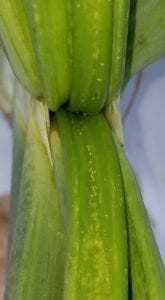Numerous intense rainstorms that have moved across Ohio during the 2021 growing season so far have created conditions for the establishment and spread of bacterial diseases. Unseasonably cool weather in early June plus rain favored leaf spots and blights caused by Pseudomonas spp. such as bacterial leaf spot of parsley and peppery spot of crucifers. In late June we are seeing bacterial diseases favored by rain and warmer weather, caused by Xanthomonas spp., such as
black rot in crucifers and leaf spot of radish. These bacteria enter vegetable crops through infested seeds and seedlings, overwintered crop debris or weeds. Epidemics tend to be more severe when started at the seed or seedling stage. Other bacterial diseases to watch for this summer are bacterial canker of tomato and pepper (Clavibacter), bacterial wilt of cucurbits (Erwinia), yellow vine decline of cucurbits (Serratia), and various soft rots (Pectobacterium).
Bacterial disease symptoms can be similar to those caused by certain fungi or oomycetes, so an accurate diagnosis should be obtained before applying fungicides or bactericides. When in doubt, growers may send samples to us for diagnosis. A simple microscopic evaluation for bacterial streaming from diseased tissue allows us to separate bacterial diseases from others (see image, right). Thanks to financial support from the Ohio Produce Growers and Marketers Association’s Ohio Vegetable and Small Fruit Research and Development Program, there is no fee for this service for Ohio commercial vegetable growers.
Unfortunately, bacterial diseases are very difficult to manage in susceptible varieties at the field stage if rainy conditions persist. The go-to treatment for bacterial diseases in the field has been a fixed copper product with or without mancozeb. However, copper application has never been highly effective due to its inability to reach the inside of plants, relatively low residuals and sensitivity to pH. It is not uncommon for bacterial populations in a leaf with lesions to exceed 100 million bacterial cells per gram of leaf tissue. Copper compounds in currently available products are too large to enter lesions and thus high levels of inoculum are protected. In addition, our research and studies conducted in other states have shown high levels of resistance to copper in Xanthomonas spp. causing bacterial spot of tomato and pepper. Other bacterial species also develop copper resistance.
So what can be done if a bacterial disease is found in an open-field vegetable crop? If it is early in the epidemic and few plants with symptoms are observed during scouting, various non-copper-based products can be applied preventatively. These products are listed in my July 18, 2020 post. Many of these products, falling in three categories of 1) plant resistance inducers, 2) antimicrobials and 3) antibacterial viruses have been shown to be partially effective under low- to moderate-disease pressure. If disease pressure is high, and rainy, humid conditions persist, these products are not likely to control a bacterial disease epidemic.
















